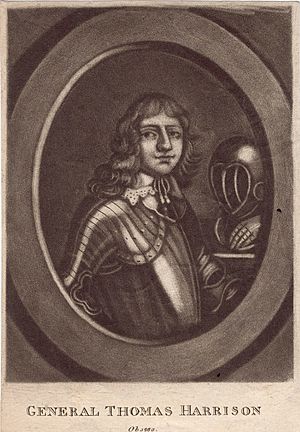Thomas Harrison (soldier) facts for kids
Quick facts for kids
Major General
Thomas Harrison
|
|
|---|---|
 |
|
| Nominated to Barebone's Parliament | |
| In office February 1653 – December 1653 |
|
| Member of Parliament for Wendover |
|
| In office May 1646 – April 1653 |
|
| Personal details | |
| Born | 1616 Newcastle-under-Lyme |
| Died | 13 October 1660 (aged 44) Tyburn |
| Cause of death | Executed |
| Spouse | Catherine Harrison (1646–his death) |
| Children | 3 died as infants |
| Occupation | Law clerk |
| Military service | |
| Allegiance | Parliamentarian |
| Rank | Major General |
| Battles/wars | |
Major-General Thomas Harrison was an important soldier and religious leader in 17th-century England. He was born in 1616 and died in 1660. He fought for the Parliament during the Wars of the Three Kingdoms. These wars were a series of conflicts across England, Scotland, and Ireland.
Harrison was a strong supporter of Oliver Cromwell, a famous military and political leader. He also played a role in the decision to execute King Charles I in 1649. Later, he disagreed with Cromwell when Cromwell became Lord Protector. After the king's son, Charles II, returned to power in 1660, Harrison was arrested. He was found guilty of treason for his part in the king's execution. He was executed on October 13, 1660. Many people, including the writer Samuel Pepys, noted his bravery during his execution.
Contents
Early Life and Family
Thomas Harrison was born on July 16, 1616. He was the second of four children. His father, Richard Harrison, was the mayor of Newcastle-under-Lyme four times. Thomas was his parents' only son.
In 1646, Thomas Harrison married his cousin, Catherine Harrison. They had three children together, but sadly, all of them died when they were babies.
Joining the Army
Thomas Harrison likely went to a local Grammar school when he was young. After school, he moved to London and became a law clerk. This meant he worked for a lawyer.
When the First English Civil War started in 1642, Harrison joined the Parliamentarian army. He became part of the personal guards of the Earl of Essex, who was the army's commander. This group was made up mostly of law students and lawyers. Other members included Charles Fleetwood and Edmund Ludlow, who also became important figures. This unit fought in early battles like Powick Bridge and Edgehill in 1642.
In 1643, Harrison moved to a different army group called the Eastern Association. He became a captain in a cavalry troop. By 1644, he was a lieutenant-colonel and fought in the important Battle of Marston Moor.
Rising Through the Ranks
Thomas Harrison fought in many major battles during the war. In 1645, he joined the New Model Army. This was a very well-organized army created by Parliament. By the end of the war, he had become a Major General. He was also a close friend and supporter of Oliver Cromwell.
In 1646, he was elected to the Long Parliament to represent Wendover. His army group had strong beliefs similar to the Levellers, a group who wanted more equality. Some of his soldiers even rebelled in 1647.
Role in the King's Trial
When the war started again in 1648, Harrison was injured at Appleby. He had to go back to London to recover. However, he was well enough to lead the group that brought King Charles I to London in January 1649.
Harrison served as a judge, or commissioner, at the king's trial. He was one of 59 commissioners who signed the document ordering King Charles I's death. This made him a "regicide," meaning someone who took part in killing a king.
Later Military and Political Life
In 1650, Harrison was given a military command in Wales. He was known for being very strict there. He was promoted to Major-General in 1651. He commanded the army in England while Oliver Cromwell was on a military campaign in Scotland. Harrison fought in the battle of Knutsford in August 1651 and the Battle of Worcester in September 1651.
By the early 1650s, Harrison became a key speaker for the Fifth Monarchists. This was a radical religious group who believed that Jesus would soon return to rule the world. He still supported Cromwell and helped him close down the Rump Parliament in April 1653. Harrison believed Parliament was stopping important religious changes. He wanted a government that was more "godly."
Harrison was a radical member of the Nominated Assembly, also known as the Barebone's Parliament, which replaced the Rump Parliament. When this assembly was closed, Harrison and others refused to leave. Soldiers had to force them out. Harrison was then removed from the Army in December 1653.
He was very upset when the Protectorate was formed and Cromwell became Lord Protector. During the Protectorate (1653–1660), Harrison was put in prison four times.
Arrest and Execution
After Cromwell died, Harrison stayed quietly at home. He did not support any of the people trying to gain power. When King Charles II returned to power in 1660, Harrison chose not to run away. He was arrested in May 1660.
His trial took place on October 11, 1660. Thomas Harrison was the first of the "regicides" to be executed on October 13, 1660. He faced his execution bravely.
Samuel Pepys, who saw the execution at Charing Cross, wrote that Major-General Harrison looked "as cheerful as any man could do in that condition." There is a plaque near Pepys Street that quotes this account. In his final moments, as he was led to the scaffold, Harrison forgave his executioner. He also gave all the money he had to the executioner before he died.


